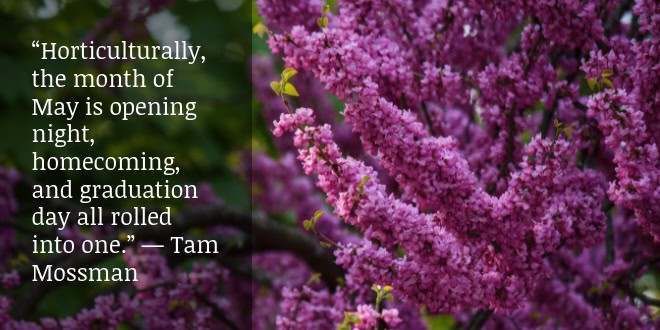
I apologize for the tardiness of this month’s newsletter. We have been so incredibly busy receiving deliveries lately that I haven’t had the brain cells to even think about trying to make any sense out of what we need to be doing in our gardens now. The good news is that we have gotten in some really great stuff that we think you’re going to want for your gardens and homes! And now that deliveries are slowing down, I think I can take a stab at getting thoughts together for you.
Jennifer
This month’s issue of Let’s Get Gardening
Subscribe to our monthly newsletter for seasonal gardening advice and recommendations for your garden, yard, and bird feeding.
I’m going to go out on a limb and say that we might, maybe, possibly be getting past the threat of frost in Southeast Michigan. I would still advise against putting any of our favorite warm-weather annual flowers and veggies out just yet, but there are lots of others that can tolerate some dips in the temperatures.
Vegetables and Herbs:
-
- If you haven’t gotten onions and potatoes in yet, do that ASAP so that they have enough time to produce in our generally short growing season. It’s getting on the late side for planting out cool-weather veggies, but if we don’t get a fast warm up to the real hot stuff, some of them will still do well if planted right away, including broccoli, cabbage, kale, and head lettuce. These should all go in as seedlings now.
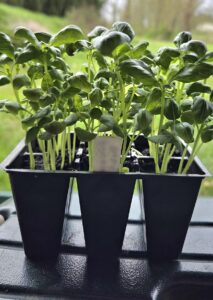
- Parsley, thyme, sage, and oregano seedlings can be planted out early in the month. Other herbs, such as rosemary, basil, cilantro, and dill should wait until all danger of frost has passed. Basil especially should not be planted too early, as it doesn’t do well in temperatures under 50°. Don’t forget, if you are starting seedlings yourself, to fully harden off those plants before you put them out into the garden
- Seeds to plant early this month, if you haven’t already, include leaf lettuce, spinach, carrots, radishes, and beets. Corn can go in soon, but beans should wait until about mid-month, if the soil has warmed up enough. It’s important to plant seeds when the soil temperature is right for that type of seed, because every seed has a temperature range at which it will germinate.
- If you are starting your own plants, it’s time to start your squash and cucumber seeds indoors, so that they are ready to transplant outside at the end of the month. However, seeds for these and others in the cucurbit family, such as pumpkins and melons, can also be planted directly in the garden around the end of the month. There are pros and cons to both approaches. The cons to starting them indoors is that most vining plants don’t like to have their roots disturbed once they get going. So, transplanting can be a shock to the plants that they may take some time to recover from – if they recover at all. On the other hand, planting out seedlings gives you a jump on the season, so you might see fruits sooner.
-
Once the soil has warmed up to above 60° and nighttime temperatures are consistently above 50°, it’s safe to plant tomato, pepper, eggplant, squash, and cucumber seedlings. Around here, that typically means about Memorial Day weekend. If we get an early warm-up, you might be able to get some of those in sooner – just be sure to have something available to cover them with if we get a cold snap, as low temps can hurt these tender plants. Lightweight frost blankets are best – they keep the warmth in without being so heavy that you risk harming the plants.
Flowers:
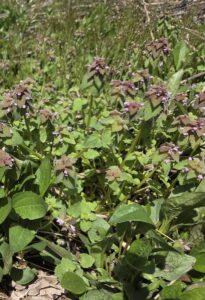 Now is a great time to get a jump on weeds, before they get out of control. I’ve been spending any spare time I have trying to eradicate a few weeds that I let take over one of my native plant beds last year, because I didn’t have any spare time then. I’ve been fighting purple deadnettle, stinging nettle, creeping charlie, creeping veronica, hairy bittercress, garlic mustard, dandelions, Canada thistle, and lots of grasses. Trust me when I tell you that it would have been a lot easier if I had not let these things get out of control!Some things to learn from my problems:
Now is a great time to get a jump on weeds, before they get out of control. I’ve been spending any spare time I have trying to eradicate a few weeds that I let take over one of my native plant beds last year, because I didn’t have any spare time then. I’ve been fighting purple deadnettle, stinging nettle, creeping charlie, creeping veronica, hairy bittercress, garlic mustard, dandelions, Canada thistle, and lots of grasses. Trust me when I tell you that it would have been a lot easier if I had not let these things get out of control!Some things to learn from my problems:
Do Not let hairy bittercress go to seed. This plant has a lovely way of spreading its seeds far-and-wide: when touched, even lightly, the plant shoots its seeds out as far as 16 feet! I can tell you from experience that having a plant spit its seeds at you is an unnerving thing! When dealing with Canada thistle, don’t pull the plants out by the roots. As much as you want to, you will live to regret it because all that does is stimulate the plant to put more roots out from the bits of root you leave behind (it’s impossible to get them all), and those roots can extend as far as 25 feet! This plant is best dealt with by cutting it down, before it gets more than two inches tall, just below the soil surface –over-and-over again.- Most perennials can be planted any time now – sooner is even a little better than later, as you want them to have a chance to get well-rooted before the hot, dry weather sets in. This is also a good time to divide late-spring and summer-blooming plants. Plants that have outgrown their space or are getting bare spots in the centers should be dug up, divided, and replanted.
- It’s still a little too early to plant most annuals. By about mid-month, it should be OK, depending on the temperatures. Remember, all the annuals available now have been living in heated green houses. Putting them in the ground right now would only shock them and slow their growth. Like our warm-weather veggies, for most annual flowers, it’s better to wait until the soil has warmed up to at least 60° and nighttime temperatures are consistently above 50°.
- Patio pots and hanging baskets can be put out now, but you will want to bring them inside at night (an attached garage is fine), if the temps are dipping below about 40°. Keep an eye on watering your container plants – if it’s sunny and/or windy, they will dry out more quickly than plants in the ground, especially as the season goes on and they fill their containers with roots.
Trees and Shrubs:
- Now is a good time to plant new trees and shrubs, while it’s still pretty cool and we’re getting regular rain. The most important thing you can do for your trees and shrubs is to keep them well-watered when mother nature isn’t, especially for the first couple of years after they are planted, while they get their roots established. A slow, soaking watering is best. Dumping a large amount of water on them all at once will generally lead to the water running off before it can get to the roots of the plants.
- Once your early-blooming shrubs, such as forsythia and quince, have dropped their blossoms, you can prune them back for better growth in the future. Letting them go without regular pruning will cause them to have leaves and flowers on the ends of long, mostly leafless branches. An annual pruning will keep them looking full and give you more blossoms.
- While we’re on the topic of pruning, May is Oak Wilt Awareness Month in Michigan, and one of the most important things to know about it is that you should not prune Oak trees between April 15th and July 15th. If you have oaks on your property, and you’re not familiar with Oak Wilt, it’s something you will want to learn about, because of the danger it poses to oak trees.
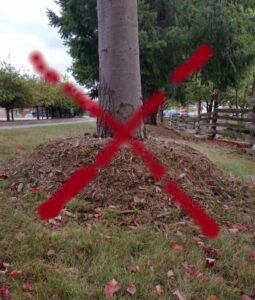
- Mulch is the second most important thing you can do for your trees and shrubs (second only to watering), because it helps to keep the soil around the roots moist and helps to maintain a more consistent soil temperature, as well as keeping weeds down. Don’t mulch too soon though, as that will keep the soil cooler, which can slow down growth. When you are mulching trees, avoid creating mulch “volcanoes” (piling mulch up around the trunk), which can slowly kill your trees.
For the Birds:
- Hummingbirds and Orioles have arrived in Michigan, so get your feeders out, if you haven’t already. I saw my first hummingbird yesterday, and I have spotted at least a couple of Baltimore Orioles at my feeders over the course of the last week or so. Remember to change the nectar in these feeders regularly – a minimum of once a week when the weather is cool, and as much as every-other-day when it’s really hot. Sugar water that is left for too long can breed bacteria, which is harmful to the birds.
- Keep your seed feeders full at this time as well. Our birds are busy building nests, laying eggs, and raising baby birds – all hard work that requires lots of nutrition. Yes, there are plenty of insects out there now, but providing easy access to food will get them to stick around your yard, which means lots of entertainment for you. Just be sure to keep your feeders clean.
- It’s also time to put out bird baths, if you haven’t already, and fill them up. Again, keep them cleaned out to prevent disease.
Read More
More info on all of these tips can be found in our monthly newsletter: Read the full May 2025 issue of Let’s Get Gardening
Happy Gardening!
12th Annual Pottery Sale Going on Now!
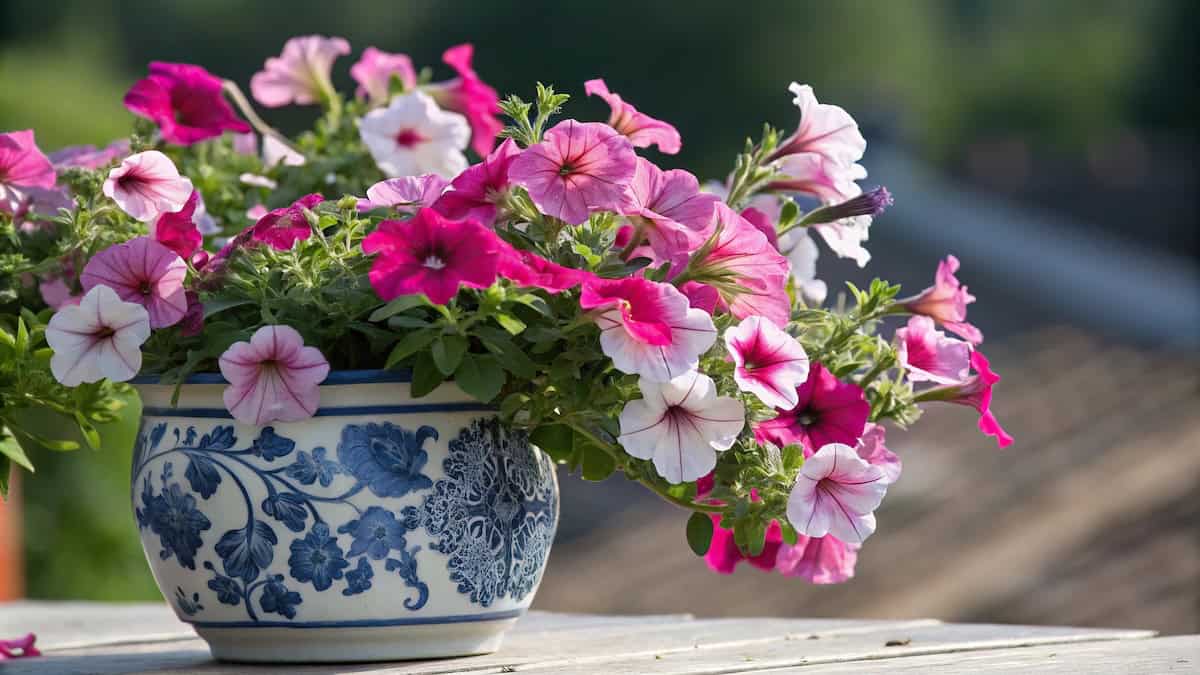
10% to 50% Off In-Store and Online!
$10 off any $50 purchase

Expires 5/31/25
Cannot be combined with any other offer.
Not valid on artist consignment items.
Cannot be used to purchase gift certificates.
